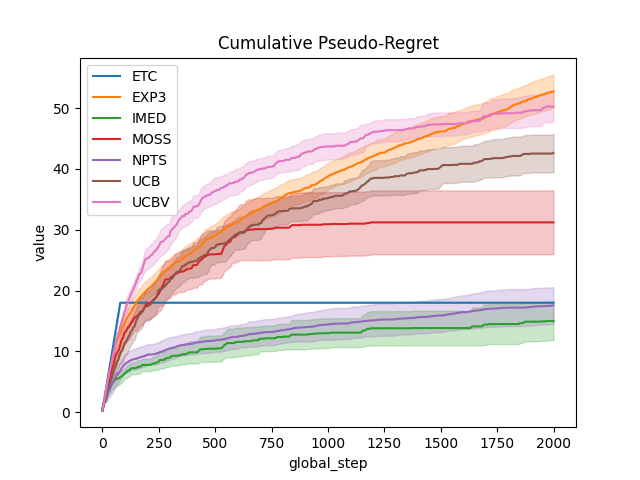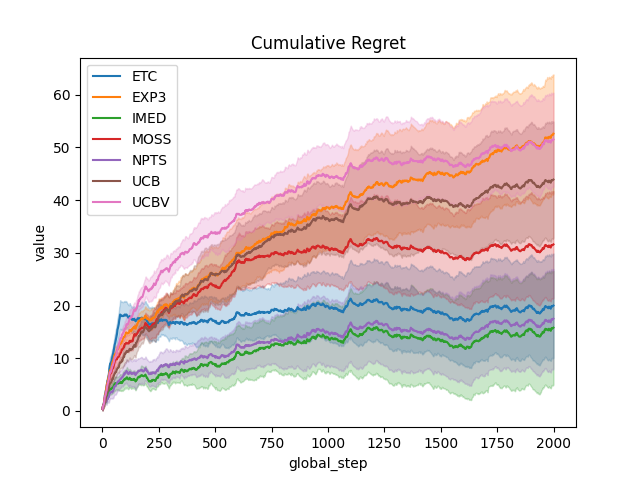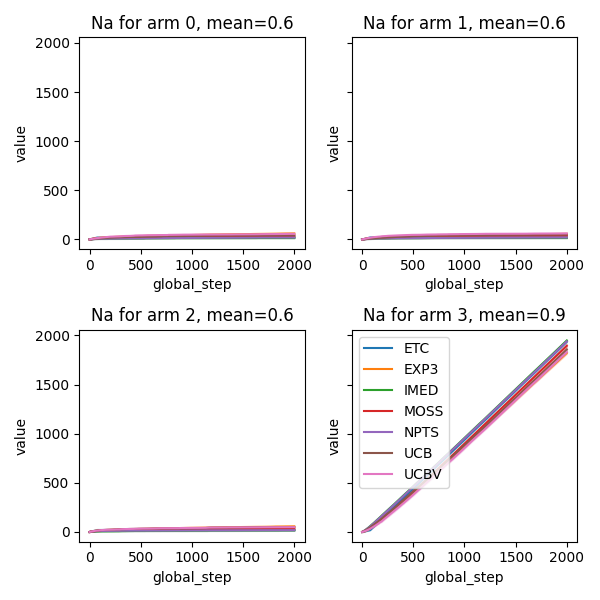Note
Go to the end to download the full example code
Comparison subplots of various index based bandits algorithms¶
This script Compare several bandits agents and as a sub-product also shows how to use subplots in with plot_writer_data
import numpy as np
import matplotlib.pyplot as plt
from rlberry_research.envs.bandits import BernoulliBandit
from rlberry.manager import ExperimentManager, plot_writer_data
from rlberry_research.agents.bandits import (
IndexAgent,
RandomizedAgent,
makeBoundedIMEDIndex,
makeBoundedMOSSIndex,
makeBoundedNPTSIndex,
makeBoundedUCBIndex,
makeBoundedUCBVIndex,
makeETCIndex,
makeEXP3Index,
)
# Agents definition
# Parameters of the problem
means = np.array([0.6, 0.6, 0.6, 0.9]) # means of the arms
A = len(means)
T = 2000 # Horizon
M = 10 # number of MC simu
# Construction of the experiment
env_ctor = BernoulliBandit
env_kwargs = {"p": means}
class UCBAgent(IndexAgent):
name = "UCB"
def __init__(self, env, **kwargs):
index, _ = makeBoundedUCBIndex()
IndexAgent.__init__(
self, env, index, writer_extra="action_and_reward", **kwargs
)
class UCBVAgent(IndexAgent):
name = "UCBV"
def __init__(self, env, **kwargs):
index, params = makeBoundedUCBVIndex()
IndexAgent.__init__(
self,
env,
index,
writer_extra="action_and_reward",
tracker_params=params,
**kwargs
)
class ETCAgent(IndexAgent):
name = "ETC"
def __init__(self, env, m=20, **kwargs):
index, _ = makeETCIndex(A, m)
IndexAgent.__init__(
self, env, index, writer_extra="action_and_reward", **kwargs
)
class MOSSAgent(IndexAgent):
name = "MOSS"
def __init__(self, env, **kwargs):
index, _ = makeBoundedMOSSIndex(T, A)
IndexAgent.__init__(
self, env, index, writer_extra="action_and_reward", **kwargs
)
class IMEDAgent(IndexAgent):
name = "IMED"
def __init__(self, env, **kwargs):
index, tracker_params = makeBoundedIMEDIndex()
IndexAgent.__init__(
self,
env,
index,
writer_extra="action_and_reward",
tracker_params=tracker_params,
**kwargs
)
class NPTSAgent(IndexAgent):
name = "NPTS"
def __init__(self, env, **kwargs):
index, tracker_params = makeBoundedNPTSIndex()
IndexAgent.__init__(
self,
env,
index,
writer_extra="action_and_reward",
tracker_params=tracker_params,
**kwargs
)
class EXP3Agent(RandomizedAgent):
name = "EXP3"
def __init__(self, env, **kwargs):
prob, tracker_params = makeEXP3Index()
RandomizedAgent.__init__(
self,
env,
prob,
writer_extra="action_and_reward",
tracker_params=tracker_params,
**kwargs
)
Agents_class = [
ETCAgent,
EXP3Agent,
IMEDAgent,
MOSSAgent,
NPTSAgent,
UCBAgent,
UCBVAgent,
]
agents = [
ExperimentManager(
Agent,
(env_ctor, env_kwargs),
fit_budget=T,
n_fit=M,
parallelization="process",
mp_context="fork",
seed=42,
)
for Agent in Agents_class
]
# these parameters should give parallel computing even in notebooks
# Agent training
for agent in agents:
agent.fit()
# Compute and plot regret
def compute_regret(rewards):
return np.cumsum(np.max(means) - rewards)
# Compute and plot (pseudo-)regret
def compute_pseudo_regret(actions):
return np.cumsum(np.max(means) - means[actions.astype(int)])
output = plot_writer_data(
agents,
tag="action",
preprocess_func=compute_pseudo_regret,
title="Cumulative Pseudo-Regret",
linestyles=True,
)
output = plot_writer_data(
agents,
tag="reward",
preprocess_func=compute_regret,
title="Cumulative Regret",
linestyles=True,
)
# Compute and plot number of times each arm was selected
def compute_na(actions, a):
return np.cumsum(actions == a)
fig, axes = plt.subplots(2, 2, sharey=True, figsize=(6, 6))
axes = axes.ravel()
for arm in range(A):
output = plot_writer_data(
agents,
tag="action",
preprocess_func=lambda actions: compute_na(actions, arm),
title="Na for arm " + str(arm) + ", mean=" + str(means[arm]),
ax=axes[arm],
show=False,
linestyles=True,
)
fig.tight_layout()
plt.show()
Total running time of the script: (0 minutes 38.872 seconds)


